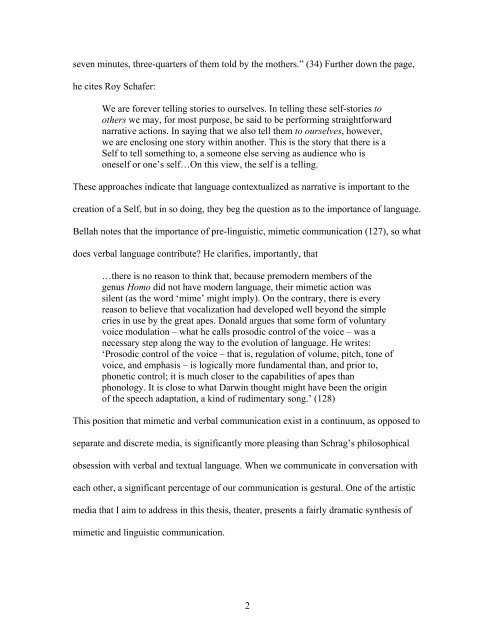The Intersection of Karuk Storytelling and Education
The Intersection of Karuk Storytelling and Education
The Intersection of Karuk Storytelling and Education
Create successful ePaper yourself
Turn your PDF publications into a flip-book with our unique Google optimized e-Paper software.
seven minutes, three-quarters <strong>of</strong> them told by the mothers.” (34) Further down the page,<br />
he cites Roy Schafer:<br />
We are forever telling stories to ourselves. In telling these self-stories to<br />
others we may, for most purpose, be said to be performing straightforward<br />
narrative actions. In saying that we also tell them to ourselves, however,<br />
we are enclosing one story within another. This is the story that there is a<br />
Self to tell something to, a someone else serving as audience who is<br />
oneself or one’s self…On this view, the self is a telling.<br />
<strong>The</strong>se approaches indicate that language contextualized as narrative is important to the<br />
creation <strong>of</strong> a Self, but in so doing, they beg the question as to the importance <strong>of</strong> language.<br />
Bellah notes that the importance <strong>of</strong> pre-linguistic, mimetic communication (127), so what<br />
does verbal language contribute? He clarifies, importantly, that<br />
…there is no reason to think that, because premodern members <strong>of</strong> the<br />
genus Homo did not have modern language, their mimetic action was<br />
silent (as the word ‘mime’ might imply). On the contrary, there is every<br />
reason to believe that vocalization had developed well beyond the simple<br />
cries in use by the great apes. Donald argues that some form <strong>of</strong> voluntary<br />
voice modulation – what he calls prosodic control <strong>of</strong> the voice – was a<br />
necessary step along the way to the evolution <strong>of</strong> language. He writes:<br />
‘Prosodic control <strong>of</strong> the voice – that is, regulation <strong>of</strong> volume, pitch, tone <strong>of</strong><br />
voice, <strong>and</strong> emphasis – is logically more fundamental than, <strong>and</strong> prior to,<br />
phonetic control; it is much closer to the capabilities <strong>of</strong> apes than<br />
phonology. It is close to what Darwin thought might have been the origin<br />
<strong>of</strong> the speech adaptation, a kind <strong>of</strong> rudimentary song.’ (128)<br />
This position that mimetic <strong>and</strong> verbal communication exist in a continuum, as opposed to<br />
separate <strong>and</strong> discrete media, is significantly more pleasing than Schrag’s philosophical<br />
obsession with verbal <strong>and</strong> textual language. When we communicate in conversation with<br />
each other, a significant percentage <strong>of</strong> our communication is gestural. One <strong>of</strong> the artistic<br />
media that I aim to address in this thesis, theater, presents a fairly dramatic synthesis <strong>of</strong><br />
mimetic <strong>and</strong> linguistic communication.<br />
2
















